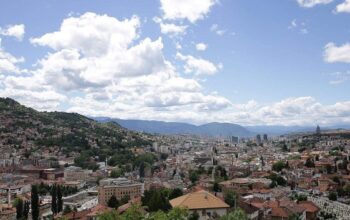On 22 April 2012, the Government of Republika Srpksa will be commemorating the sixty-seventh anniversary of when the Jasenovac concentration camp – the most lethal of the World War II camps in the Balkans – was forced to cease its operation on account of an inmate revolt. While the term “genocide” continues to spark controversy and heated debate regarding the events of the war that ravaged the region between 1992 and 1995, many seem either to have forgotten or to be unaware that an almost unthinkable genocidal campaign dramatically changed the demographics of the Western Balkans less than a century ago.
The Croatian Ustaše regime was a fascist movement that developed out of Zagreb in the late 1920s. By 1933, the movement had organized itself under the leadership of Anton Pavelić and unveiled its “Seventeen Principles,” focusing principally on Croatian identity expressed through an independent Croatian state. Pavelić was arrested and the Ustaše movement was banned when the leaders organized and carried out the assassination of Yugoslavian King Alexander I during a state visit to France in 1934. The ban, however, only drew attention to the movement, causing it to grow underground.
On 6 April 1941, the forces of Nazi Germany invaded Yugoslavia, creating the opportunity for the Ustaše to reemerge. After taking control of the Zagreb police on 10 April, Ustaše leaders announced the formation of the Independent State of Croatia. Upon returning from Italy where he had been in exile, Anton Pavelić announced a new government on 16 April, declaring himself the “Poglavnik”, the Croatian equivalent of “Führer”. The Independent State of Croatia, however, proceeded with a decided lack of independence, as the territory was divided as part Italian and part German protectorates. The Croatian fascist regime, therefore, existed as a puppet state of the Axis Powers for most of the Second World War.
Under this political framework, the Ustaše leaders took it upon themselves to cleanse their new “state” of those who were not “Croatian.” To this end, the government declared that Catholicism and Islam were Croatian religions, but that Orthodox Christianity, as well as Judaism, was abhorrent. With this ideology, the Ustaše initiated a genocidal campaign to rid the region of Serbs, Jews, and Roma—those who threatened the purity of their state—as well as any individuals deemed to be anti-fascist. To implement their plans, they established a series of concentration camps which they used to exterminate the undesirable populations.
By 1942, news of the Jasenovac Concentration Camp began to spread. Rather than a single unit, the Jasenovac Camp was a complex of five affiliate camps each tasked with different responsibilities. Indeed, even the Nazis were disturbed to discover camps within Jasenovac established specifically to kill women (Stara Gradiška) and children (Sisak). The complex extended over the Sava River into Donja Gradina in the northern portion of the modern Republika Srpska in Bosnia & Herzegovina. A 1942 Gestapo report to Heinrich Himmler described the Ustaše’s treatment of the Serbs as “bestial,” especially with regard to the treatment of the elderly, women, and children, and informed the Nazi leadership that the regime had already massacred and sadistically tortured to death roughly 300,000 people.
The precise number of victims of the Ustaše regime remains unknown and highly disputed. While it is estimated that the overall genocidal campaign killed between 1 million and 1.7 million people, the debate about the exact numbers should never be used to trivialize the magnitude of the suffering inflicted or the tragedy of the many innocent lives that were lost. In the Balkans, the overwhelming majority of victims were Serbs, followed by Jews, Roma, and anti-fascists. The signs at the Donja Gradina Memorial Site commemorate the deaths of 700,000 individuals of whom 500,000 were Serbs, 127,000 anti-fascists (including Croats and Muslims), 40,000 Roma, 33,000 Jews, and 20,000 children. The treatment of inmates in Ustaše camps was often even more terrifying than in other Holocaust camps in Europe—random killings (often by slitting inmates’ throats with a special knife that came to be known as a “Serb Cutter”), impromptu massacres, and brutal torture were all commonplace.
In April 1945, the Ustaše sped up the mechanisms for extermination, as the Partisan rebels fighting to establish a Communist Yugoslav state were getting very close to Jasenovac. On 22 April of that year, the remaining 600 inmates revolted, putting a final end to the operation of the camp. Unfortunately, 520 of the inmates were killed in the process and only 80 escaped. Unlike many of the other death camps in Europe, the Jasenovac camp was razed, thus leading the world to overlook and gradually forget the horrible atrocities that occurred on the banks of the Sava.
The Donja Gradina Memorial Site, first established as part of a Yugoslav memorial in 1983 and later as a Bosnian & Herzegovinian site in 1991, centers on the giant poplar tree that was used as the principal gallows of the Jasenovac complex. The RS Government ceremony on 22 April 2012 will commemorate all the victims—Serb, Jewish, Roma, and anti-fascist—of the Ustaše regime. As the victims also included Catholics and Muslims who opposed the Ustaše, they too will be remembered at this event. The RS recognizes that the tragedy did not fall perfectly on ethnic lines, and seeks to bring together religious and political leaders of different faiths and backgrounds to remember all those who suffered and perished in that awful period of history. Furthermore, the RS Government will be laying the cornerstone for further development of the Memorial Site to ensure that the unfathomable horrors are not forgotten.


